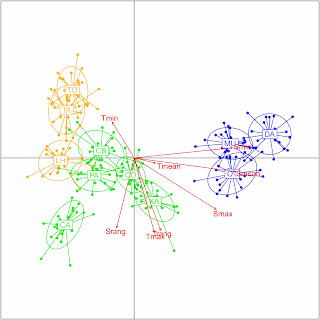By Xavier Turon
The two sides of the Mediterranean: population
genomics of the black sea urchin Arbacia lixula (Linnaeus, 1758) in a
warming sea.
By Carreras, Ordóñez, García-Cisneros, Wangensteen, Palacín,
Pascual, Turon
We are
happy to have finally published our work on the population genomics of one of
the focal species of PopCOmics, the black sea urchin Arbacia lixula. The
new open access paper in Frontiers in Marine Science can be found at:
https://www.frontiersin.org/articles/10.3389/fmars.2021.739008/full
This
article is a good counterpart to the one we published previously on the other dominant
sea urchin species in the shallow Mediterranean: the purple sea urchin Paracentrotus
lividus (Carreras et al 2020, available at https://onlinelibrary.wiley.com/doi/full/10.1111/ddi.13016).
Both species are important ecosystem engineers. It is interesting to note the
differences in population parameters of two species with similar larval
lifespans, such as a more marked effect of the Almería-Oran front in the purple
than in the black sea urchin. For the latter, only a clear differentiation
between populations in the eastern and the western basin was detected. Salinity,
rather than temperature, seems to drive adaptive responses in Arbacia lixula.
Overall, the scenario of an increased dominance of the black sea urchin in a
warming Mediterranean seems plausible.
Here is the abstract:
Global environmental changes may have a profound impact on ecosystems. In this context, it is crucial to gather biological and ecological information of the main species in marine communities to predict and mitigate potential effects of shifts in their distribution, abundance, and interactions. Using genotyping by sequencing (GBS), we assessed the genetic structure of a keystone species in the Mediterranean shallow littoral ecosystems, the black sea urchin Arbacia lixula. This bioengineer species can shape their communities due to its grazing activity and it is experiencing an ongoing expansion with increasing temperatures. The population genomic analyses on 5,241 loci sequenced in 240 individuals from 11 Mediterranean sampled populations revealed that all populations were diverse and showed significant departure from equilibrium. Albeit genetic differentiation was in general shallow, a significant break separated the western and eastern Mediterranean populations, a break not detected in previous studies with less resolutive markers. Notably, no clear effect of the Almería-Oran front, an important break in the Atlanto-Mediterranean transition, could be detected among the western basin populations, where only a slight differentiation of the two northernmost populations was found. Despite the generally low levels of genetic differentiation found, we identified candidate regions for local adaptation by combining different genomic analysis with environmental data. Salinity, rather than temperature, seemed to be an important driver of genetic structure in A. lixula. Overall, from a population genomics standpoint, there is ample scope for A. lixula to continue thriving and adapting in the warming Mediterranean.
Results of a DAPC ordination of samples, with the fitted vectors of environmental variables superimposed

